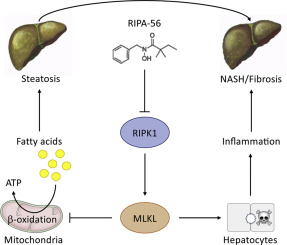当前位置:
X-MOL 学术
›
J. Hepatol.
›
论文详情
Our official English website, www.x-mol.net, welcomes your
feedback! (Note: you will need to create a separate account there.)
Inhibition of receptor-interacting protein kinase 1 improves experimental non-alcoholic fatty liver disease
Journal of Hepatology ( IF 26.8 ) Pub Date : 2020-04-01 , DOI: 10.1016/j.jhep.2019.11.008 Amine Majdi 1 , Lynda Aoudjehane 1 , Vlad Ratziu 2 , Tawhidul Islam 3 , Marta B Afonso 4 , Filomena Conti 5 , Taïeb Mestiri 1 , Marie Lagouge 6 , Fabienne Foufelle 6 , Florine Ballenghien 1 , Tatiana Ledent 7 , Marthe Moldes 1 , Axelle Cadoret 1 , Laura Fouassier 1 , Jean-Louis Delaunay 1 , Tounsia Aït-Slimane 1 , Gilles Courtois 8 , Bruno Fève 9 , Olivier Scatton 10 , Carina Prip-Buus 11 , Cecília M P Rodrigues 4 , Chantal Housset 12 , Jérémie Gautheron 1
Journal of Hepatology ( IF 26.8 ) Pub Date : 2020-04-01 , DOI: 10.1016/j.jhep.2019.11.008 Amine Majdi 1 , Lynda Aoudjehane 1 , Vlad Ratziu 2 , Tawhidul Islam 3 , Marta B Afonso 4 , Filomena Conti 5 , Taïeb Mestiri 1 , Marie Lagouge 6 , Fabienne Foufelle 6 , Florine Ballenghien 1 , Tatiana Ledent 7 , Marthe Moldes 1 , Axelle Cadoret 1 , Laura Fouassier 1 , Jean-Louis Delaunay 1 , Tounsia Aït-Slimane 1 , Gilles Courtois 8 , Bruno Fève 9 , Olivier Scatton 10 , Carina Prip-Buus 11 , Cecília M P Rodrigues 4 , Chantal Housset 12 , Jérémie Gautheron 1
Affiliation

|
BACKGROUND & AIMS
In non-alcoholic fatty liver disease (NAFLD), hepatocytes can undergo necroptosis, a regulated form of necrotic cell death mediated by the receptor-interacting protein kinase (RIPK) 1. We herein assessed the potential of RIPK1 and its downstream effector mixed lineage kinase domain-like protein (MLKL), as therapeutic targets and markers of activity in NAFLD. METHODS
C57/BL6J-mice were fed a normal chow diet (NCD) or high fat diet (HFD). The effect of RIPA-56, a highly specific inhibitor of RIPK1, was evaluated in either a prophylactic or a curative treatment of HFD-fed mice, and in primary human steatotic hepatocytes. RIPK1 and MLKL concentrations were measured in the serum of patients with NAFLD. RESULTS
Both prophylactic and curative treatments of HFD-fed mice with RIPA-56, caused a down-regulation of MLKL and a reduction of liver injury, inflammation and fibrosis, characteristic of non-alcoholic steatohepatitis (NASH), as well as of steatosis. This latter effect was reproduced by treating primary human steatotic hepatocytes with RIPA-56 or necrosulfonamide (NSA), a specific inhibitor of human MLKL, and by knocking out (KO) MLKL in fat-loaded AML-12 mouse hepatocytes. MLKL KO in steatotic hepatocytes, caused an activation of the mitochondrial respiration, and an increase in β-oxidation. Along with MLKL decreased activation, RIPK3-KO mice exhibited increased activities of the liver mitochondrial respiratory chain complexes in experimental NASH. In patients with NAFLD, serum concentrations of RIPK1 and MLKL increased in correlation with the activity. CONCLUSION
The inhibition of RIPK1 improves NASH features in HFD-fed mice and reverses steatosis by an MLKL-dependent mechanism that involves at least partly an increase in mitochondrial respiration. RIPK1 and MLKL are potential serum markers of activity and promising therapeutic targets in NAFLD.
中文翻译:

抑制受体相互作用蛋白激酶 1 可改善实验性非酒精性脂肪肝
背景和目的 在非酒精性脂肪性肝病 (NAFLD) 中,肝细胞会发生坏死性凋亡,这是一种受受体相互作用蛋白激酶 (RIPK) 介导的受调控形式的坏死细胞死亡 1。我们在此评估了 RIPK1 及其下游效应子的潜力混合谱系激酶结构域样蛋白 (MLKL),作为 NAFLD 的治疗靶点和活性标志物。方法 C57/BL6J 小鼠被喂食正常食物 (NCD) 或高脂肪饮食 (HFD)。RIPA-56 是一种高度特异性的 RIPK1 抑制剂,在 HFD 喂养的小鼠和原代人类脂肪肝细胞的预防性或治疗性治疗中进行了评估。在 NAFLD 患者的血清中测量了 RIPK1 和 MLKL 浓度。结果 RIPA-56 对 HFD 喂养小鼠的预防性和治疗性治疗,导致 MLKL 的下调和肝损伤、炎症和纤维化的减少,这是非酒精性脂肪性肝炎 (NASH) 以及脂肪变性的特征。通过用 RIPA-56 或 necrosulfonamide (NSA)(一种人 MLKL 的特异性抑制剂)处理原代人脂肪变性肝细胞,并通过敲除(KO)负载脂肪的 AML-12 小鼠肝细胞中的 MLKL,可以重现后一种效果。脂肪变性肝细胞中的 MLKL KO 导致线粒体呼吸激活和 β-氧化增加。随着 MLKL 活化降低,RIPK3-KO 小鼠在实验性 NASH 中表现出肝脏线粒体呼吸链复合物的活性增加。在 NAFLD 患者中,RIPK1 和 MLKL 的血清浓度与活性相关地增加。结论 RIPK1 的抑制改善了 HFD 喂养小鼠的 NASH 特征,并通过 MLKL 依赖性机制逆转脂肪变性,该机制至少部分涉及线粒体呼吸的增加。RIPK1 和 MLKL 是 NAFLD 中潜在的血清活性标志物和有希望的治疗靶点。
更新日期:2020-04-01
中文翻译:

抑制受体相互作用蛋白激酶 1 可改善实验性非酒精性脂肪肝
背景和目的 在非酒精性脂肪性肝病 (NAFLD) 中,肝细胞会发生坏死性凋亡,这是一种受受体相互作用蛋白激酶 (RIPK) 介导的受调控形式的坏死细胞死亡 1。我们在此评估了 RIPK1 及其下游效应子的潜力混合谱系激酶结构域样蛋白 (MLKL),作为 NAFLD 的治疗靶点和活性标志物。方法 C57/BL6J 小鼠被喂食正常食物 (NCD) 或高脂肪饮食 (HFD)。RIPA-56 是一种高度特异性的 RIPK1 抑制剂,在 HFD 喂养的小鼠和原代人类脂肪肝细胞的预防性或治疗性治疗中进行了评估。在 NAFLD 患者的血清中测量了 RIPK1 和 MLKL 浓度。结果 RIPA-56 对 HFD 喂养小鼠的预防性和治疗性治疗,导致 MLKL 的下调和肝损伤、炎症和纤维化的减少,这是非酒精性脂肪性肝炎 (NASH) 以及脂肪变性的特征。通过用 RIPA-56 或 necrosulfonamide (NSA)(一种人 MLKL 的特异性抑制剂)处理原代人脂肪变性肝细胞,并通过敲除(KO)负载脂肪的 AML-12 小鼠肝细胞中的 MLKL,可以重现后一种效果。脂肪变性肝细胞中的 MLKL KO 导致线粒体呼吸激活和 β-氧化增加。随着 MLKL 活化降低,RIPK3-KO 小鼠在实验性 NASH 中表现出肝脏线粒体呼吸链复合物的活性增加。在 NAFLD 患者中,RIPK1 和 MLKL 的血清浓度与活性相关地增加。结论 RIPK1 的抑制改善了 HFD 喂养小鼠的 NASH 特征,并通过 MLKL 依赖性机制逆转脂肪变性,该机制至少部分涉及线粒体呼吸的增加。RIPK1 和 MLKL 是 NAFLD 中潜在的血清活性标志物和有希望的治疗靶点。











































 京公网安备 11010802027423号
京公网安备 11010802027423号